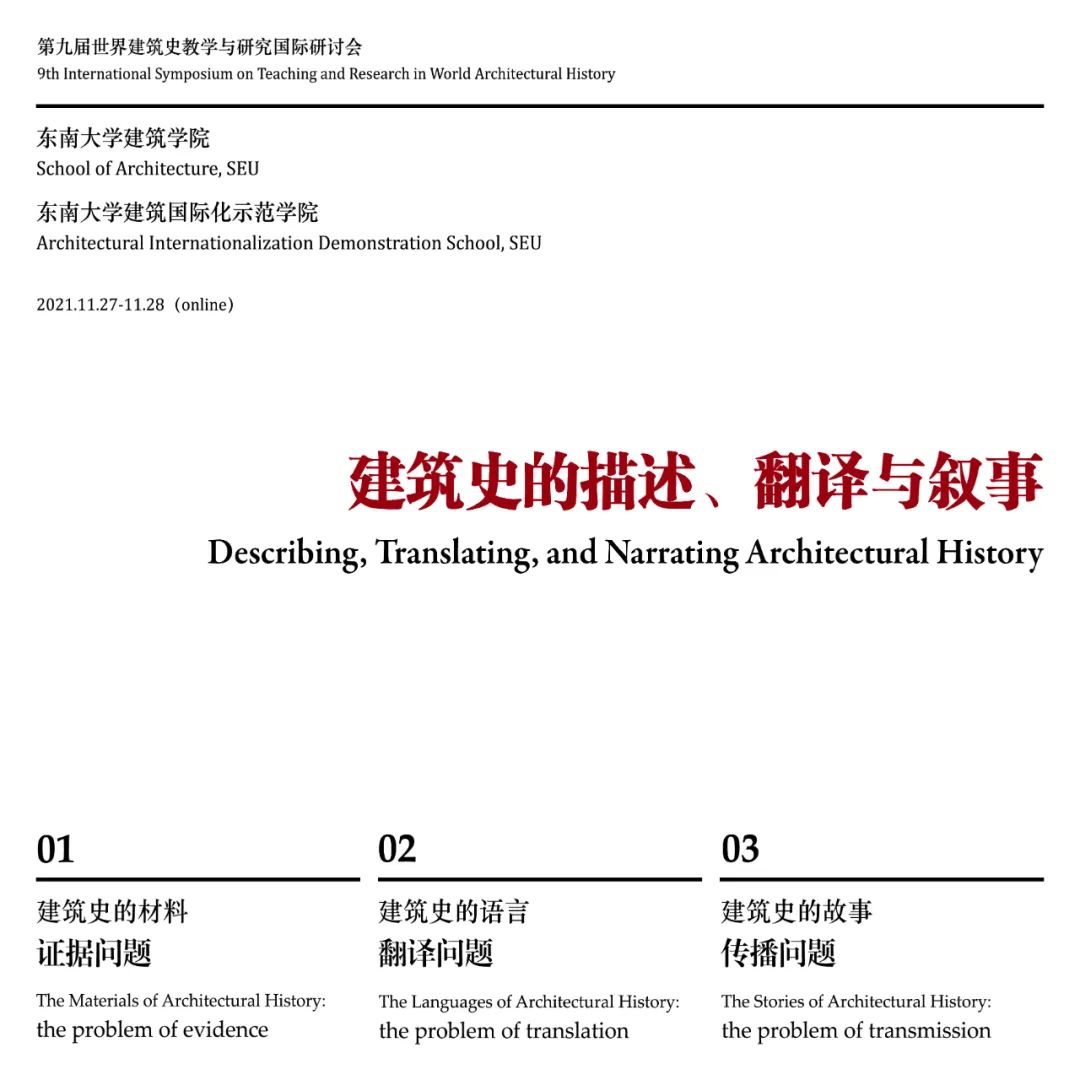
首届“世界建筑史教学与研究国际研讨会”由发起,在全国高等学校建筑学学科专业指导委员会的支持下,于2005年11月成功举办。此后每两年一届,依次在同济大学、清华大学、天津大学、重庆大学、哈尔滨工业大学、华南理工大学、西安建筑科技大学分别召开。历届研讨会聚集了国内外各相关院校从事世界建筑史教学与研究的众多专家学者,畅谈思想,交流经验。2021年11月,第九届世界建筑史教学与研究国际研讨会将以“建筑史的描述、翻译与叙事”为主题,由和东南大学建筑共同主办,以线上方式召开,拟围绕建筑史的证据、语言、传播等问题,邀请相关领域的十余名学者进行主题演讲并展开讨论。详细议程与具体安排将相继发布,敬请关注。
第九届世界建筑史教学与研究国际研讨会9th International Symposium on Teaching and Research in World Architectural History
建筑史的描述、翻译与叙事
Describing, Translating, and Narrating Architectural History
主办单位 / HOST
School of Architecture, Southeast University
东南大学建筑
Architectural Internationalization Demonstration School, Southeast University
会议主席 / CHAIR
戴维·莱瑟巴罗 David LEATHERBARROW
周琦 ZHOU Qi
会议日期 / DATE
2021.11.27-11.28
ZOOM线上召开 / To be held online with ZOOM

议题1 建筑史的材料:证据问题
该议题试图描述与说明建筑史中的材料研究问题,其中包括,它们如何被发掘,以及如何被呈现给试图了解自己身处的地方和世界其他区域的人们。不同的研究对象或者证据类别进入了这些历史——口述传统、书面档案、绘制图像与建成实物。讲授——特别是年轻教师的讲授——应当怎样把握这些出自本土与外界的史料,并将它们整合进可信而确切的描述中?
Session 1 The Materials of Architectural History: the problem of evidence
The papers in this session will describe and demonstrate the study materials of architectural history, what they are, how they come to be known, and are then presented to others seeking to understand architecture in one’s own region and other locations throughout the world. Different objects of study or kinds of evidence enter into these histories: oral traditions, written documents, drawn images, and built objects. How can teaching, particularly the teaching of younger professors, master these materials from both local and foreign locations and then in turn integrate them into accounts that are both plausible and relevant?
议题2 建筑史的语言:翻译问题
该议题试图考察建筑史面对来自世界各地的研究材料时遭遇的特殊挑战。理解的问题随之出现,其中包括将它们向本地以及其他区域的观众与读者的传播。翻译工作面对着不同的难题,解读不同的语言文字,同步不同的时间年表,协调不同的衡量尺度,以及非专业的习语或方言中的表达。鉴于翻译过程中的简化趋势,世界历史是否因此总是显得太过笼统,不够细致?又该如何规避过度的民族主义或者“殖民”倾向?又将怎样在通过译文去阅读、呈现、出版建筑的过程中保留住文化特性?
Session 2 The Languages of Architectural History: the problem of translation
The papers in this session will investigate the special challenges of histories that include study materials from locations throughout the world. Problems of understanding arise, also of transmission to auditors and readers in one’s own region and elsewhere. Included in the work of translation are challenges that result from the need to read different languages, synchronize different chronologies, and coordinate different measurements—together with non-professional idiomatic or vernacular expressions. Given the tendency toward simplification in translation, will world history always be too general, insufficiently nuanced? How can nationalist hegemonic, or “colonial” tendencies be avoided? How can cultural specificity be retained when architecture is read, presented, or published in translation?
议题3 建筑史的故事:传播问题
该议题试图讨论并说明建筑历史用以交流的几种路径,如果先行承认调查与研究将会以公开发表的方式转化为成果这一假设。在写作这种最常见的形式以外,依然存在着其他一些传播形式:建筑师与学者口头讲述项目的历史(面向学生、同事与公众),他们也会绘制图纸用来论证项目发展(包括草案、研判、重建,等等),当然也包括影响着基地周边历史的建成项目(地方的文化史与自然史)。这几种历史“写作”方式的角色是什么?是否在真实中并存着些许虚构?预期的读者又会怎样影响进行历史叙事的作者?
Session 3 The Stories of Architectural History: the problem of transmission
This session will discuss and demonstrate the several ways that architectural history is communicated, on the assumption that inquiry and research come to fruition when made public. Although writing is the most common form of dissemination, there are other forms of transmission: architects and scholars verbally narrate project histories (to students, colleagues, and the general public), they also produce drawings that attest to project development (sketches, studies, reconstructions, etc.), and, of course, architects build projects that affect the histories of their locations (the cultural and natural histories of places). What are the roles of the several modes of “writing” history? Are some more factual, others fictional? How does intended readership affect authorship in historical narration?
信息提供:教师综合支部


